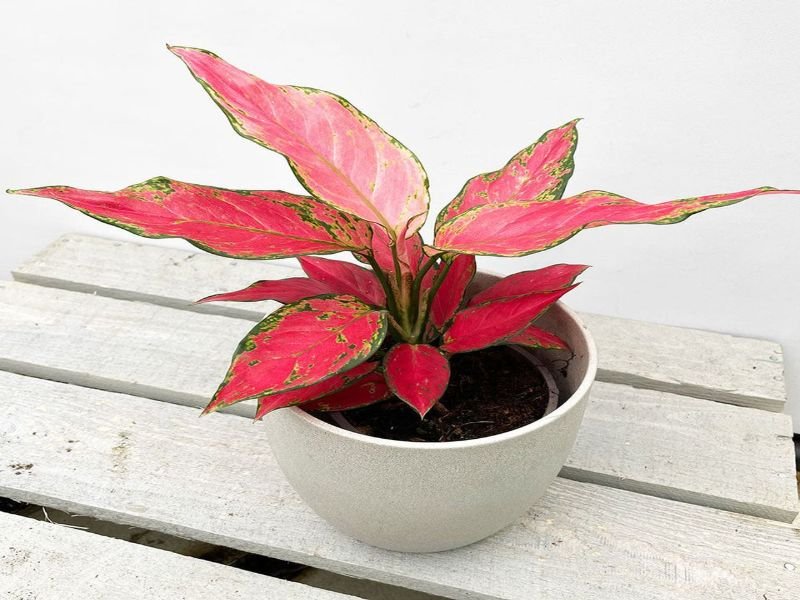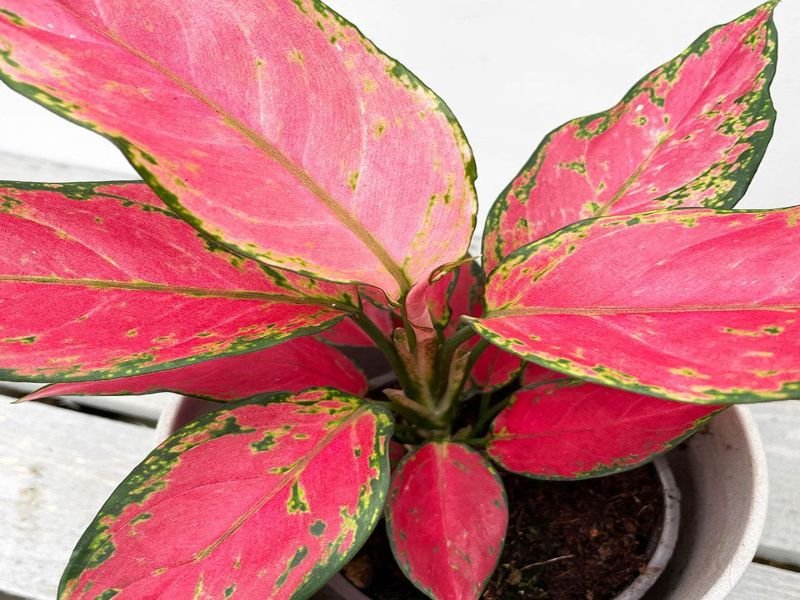Aglaonema Cherry is a stunning plant that stands out for its striking foliage and easy-to-care-for nature. This tropical evergreen plant, also known as the Chinese Evergreen, is highly valued for its unique beauty and ability to thrive in a range of environments. With its dark green leaves splashed with vibrant red hues, the Aglaonema Cherry is an eye-catching addition to any indoor space.

Table of Contents
Brief Overview of Aglaonema Cherry
The Aglaonema Cherry belongs to the Araceae family and is native to Southeast Asia. It typically grows up to 3 feet tall, making it an ideal choice for those who want a compact yet exotic-looking houseplant.
The plant’s leaves are broad and glossy with pointed tips that give it an elegant look. The red splashes on the leaves make it stand out from other plants, making it a favorite among collectors.
Importance of proper care
Proper care is key to keeping the Aglaonema Cherry healthy and thriving. Providing optimal light conditions, watering appropriately, maintaining proper temperature and humidity levels, using suitable soil, and fertilizing regularly- all these factors contribute significantly towards ensuring the plant’s longevity. Inadequate care can lead to problems such as leaf discoloration, wilting or drooping of leaves, pest infestations, and fungal infections that can weaken or even kill the plant.
Therefore, it’s important to learn how to take care of your Aglaonema Cherry properly so you can enjoy its beauty for years to come. In the following sections of this article, we will discuss in detail everything you need to know about what makes up ideal conditions for growing an Aglaonema cherry indoors- from light requirements down through propagation methods- so that you can give your lovely plant all she needs!
Description and Characteristics
Aglaonema Cherry, also known as Chinese evergreen, is an incredibly popular houseplant due to its ease of care and stunning appearance. This plant is native to the tropical regions of Southeast Asia and features dark green leaves with striking red undertones. Its leaves are typically oval-shaped and pointed, with a glossy texture that adds to its aesthetic appeal.
The Aglaonema Cherry can grow up to 3 feet tall and 3 feet wide, making it a great choice for filling up empty corners or decorating empty wall spaces. It’s a slow-growing plant that requires minimal maintenance, but if you provide it with the right care, it will reward you with lush foliage that adds life to your home or office.
Origin and History
The Aglaonema Cherry has been cultivated as a houseplant in China for centuries. It was introduced in Europe in the late 1800s and quickly became popular among gardeners due to its low maintenance requirements. However, it wasn’t until the mid-1900s that this charming plant caught on in popularity in the United States.
Today, Aglaonema Cherry is grown all over the world as an indoor ornamental plant because of its gorgeous foliage and durability. There are now more than 20 known species of Aglaonema plants available in varying colors, patterns, shapes, and sizes – each one unique.
Varieties
Within the genus, Aglaonema exists more than 100 different varieties of plants ranging from small shrubs just inches high to larger plants several feet tall. Some common varieties include; Aglaonema ‘Silver Bay’: This variety has silver-gray colored leaves bordered by dark green stripes.
Aglaonema ‘Emerald Bay’: This variety has bright green leaves and is known for its air-cleaning properties. Aglaonema ‘Red Siam’: As the name implies, this variety features bright red stems and leaves veined with red or pink stripes.
Aglaonema ‘Diamond Bay’: This plant has cream-colored leaves speckled with green spots, making it an attractive option for those looking for something a little more unique. Aglaonema Cherry is an excellent houseplant that can add life and color to any room.
It is low maintenance and comes in a wide variety of sizes and colors, making it easy to find one that suits your style. Whether you are a seasoned gardener or just starting out, the Aglaonema Cherry is a great choice for anyone looking to add some natural beauty to their home or office space.
Light Requirements
Aglaonema Cherry is a relatively low-light plant that can thrive in a variety of lighting conditions. However, in order to achieve optimal growth and vibrant foliage, certain light requirements must be met.
The best lighting conditions for Aglaonema Cherry are bright, indirect sunlight with no direct exposure to the sun’s rays. Avoid placing Aglaonema Cherry in direct sunlight as it can cause leaf scorching and discoloration.
If natural light is not available or insufficient, artificial lighting options such as fluorescent lights or LED grow lights can be used to supplement the plant’s lighting needs. When using artificial lighting sources, it’s important to ensure that the intensity and duration of light exposure are appropriate for the specific needs of Aglaonema Cherry.
Watering Needs
Proper watering is crucial for the survival and growth of any houseplant, including Aglaonema Cherry. It’s important to maintain a consistent watering schedule while taking into consideration factors such as humidity levels, soil type, and drainage capabilities. The frequency of watering will depend on various factors such as the size of the container, room temperature, humidity levels, and soil type.
In general, it’s recommended to water Aglaonema Cherry once a week or when the top inch of soil feels dry to the touch. Water quality is also important – using distilled water or allowing tap water to sit out overnight will help avoid any potential problems caused by chlorine or fluoride content.
Drainage considerations are also critical for the proper care of Aglaonema Cherry plants. These plants do not tolerate waterlogged roots well so it’s important to ensure adequate drainage by providing holes at the bottom of containers and using well-draining soils like peat moss or perlite.
Temperature and Humidity Requirements

Aglaonema Cherry prefers temperatures between 65°F to 80°F (18°C to 26°C) during the day and slightly cooler temperatures at night. It is important to keep the plant away from windows, doors, or other areas that experience drafts. Humidity is also important for this plant as it thrives in higher humidity conditions.
If your home has low humidity levels, consider using a humidifier or placing a tray of water near the plant to increase moisture levels in the air. Misting can also be beneficial but avoid misting too much as it can lead to fungal growth.
Soil Requirements
The right soil type is crucial for the proper growth and development of Aglaonema Cherry. A well-draining soil mix such as peat moss or perlite with added organic matter like compost or leaf mold will ensure proper root health and overall growth.
Fertilization is also an important aspect of soil care for Aglaonema Cherry. Use a balanced fertilizer formulated for houseplants every two weeks during the growing season (spring and summer) and reduce frequency during fall/winter months.
Propagation Methods
Aglaonema Cherry can be propagated through cutting or seed propagation methods. Cutting propagation involves taking a stem cutting with at least one node and placing it in water until roots have formed before transferring it to the soil. Seed propagation involves sowing seeds in sterile potting soil mix at a depth of 1/4 inch (6mm).
Cutting propagation is generally easier and more successful than seed propagation; however, both methods can yield successful results if done correctly. Overall, caring for Aglaonema Cherry requires attention to detail but with proper care, this beautiful plant can thrive indoors adding beauty and freshness to any space.
Common Problems and Solutions

Pest Control Measures
Aglaonema Cherry is a relatively tough plant and it can tolerate a range of pests. However, like any other houseplant, it is susceptible to certain pests that can cause damage to the leaves or stem.
Common pests found on Aglaonema Cherry include spider mites, mealybugs, scale insects, and aphids. The signs of pest infestation include yellowing leaves, sticky residue on the plant’s surface, or tiny bugs visible on the plant.
To control these pests, you should start by isolating the affected plant from other plants to prevent further spread. You can then use chemical solutions such as neem oil or insecticidal soap spray to kill pests on contact.
Another natural option is using rubbing alcohol and water solution sprayed onto affected areas. In severe cases where chemical pesticides are required always read package instructions carefully before applying.
Disease Prevention Strategies
Aglaonema Cherry is not particularly prone to diseases but improper care practices like watering too much or not providing enough sunlight may expose your plant to many potential problems including root rot which could be fatal for your Aglaonema Cherry. To prevent disease in your Aglaonema Cherry plants ensure that you follow basic care procedures such as maintaining proper soil pH level between 6-7 and ensuring proper drainage by adding sand mixed in with potting soil. Additionally keeping a humid environment around your plant helps keep at bay fungal diseases.
Leaf Discoloration Remedies
Yellowing leaves may indicate several problems including overwatering, under-watering, or lack of fertilizer causing nutrient deficiencies which all affect leaf health. To troubleshoot leaf discoloration problems start by checking if any of the causes mentioned above apply then take appropriate action such as changing the watering schedule if necessary or adding fertilizer in the required amounts. If the issue persists, it could be a sign of disease or pest infestation and you should immediately investigate further.
Summary of Key Points
The Importance of Proper Care for Healthy Growth
Aglaonema Cherry is an excellent choice for indoor plant enthusiasts. However, to ensure the healthy growth and longevity of your Aglaonema Cherry, proper care is necessary. The following key points summarize the essential elements that must be considered when caring for your Aglaonema Cherry.
Light Requirements
Aglaonema Cherry prefers bright, indirect light but can tolerate low light conditions. When providing light, it’s important to avoid direct sunlight as it can burn the leaves. Optimal lighting conditions include placing your plant near a North or East-facing window or under artificial lighting such as fluorescent or LED lights.
Watering Needs
Aglaonema Cherry thrives in moist but well-drained soil. Watering should be done regularly, but not excessively to avoid root rot.
The frequency of watering depends on several factors such as temperature, humidity levels, and soil type. It is recommended to water when the top inch of soil feels dry and at room temperature.
Temperature and Humidity Requirements
The ideal temperature range for Aglaonema Cherry is between 65-80°F(18-27°C). They prefer moderate humidity levels between 40-60%. To maintain these conditions, place a tray filled with water under your plant’s pot or use a humidifier if you live in a dry climate.
Soil Requirements
Choosing the right type of soil plays a vital role in ensuring a healthy growth for Aglaonema Cherry. Use a well-draining potting mix with added perlite or vermiculite to provide good drainage and aeration. Fertilize every 2-3 months with balanced liquid fertilizer during growing seasons (Spring-Summer)to supply essential nutrients.
Common Problems and Solutions
Aglaonema Cherry is relatively easy to care for, but like any plant, it can be susceptible to pests such as spider mites or mealybugs. Regular inspections and preventative treatments can help control pest infestations. Leaf discoloration or wilting may occur due to overwatering or underwatering.
Adjust watering habits accordingly. The key points outlined above emphasize the importance of proper care for Aglaonema Cherry’s optimal health and longevity.
By following these guidelines, you can ensure your plant thrives in your home or office environment. Remember that small adjustments in light, water, soil, and temperature could make a significant impact on your plant’s growth and overall well-being.

Gardening is my passion and growing plants indoors has always been a stress relief for me. Grow a banana tree in my apartment once (although failed to produce bananas).






